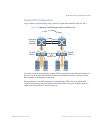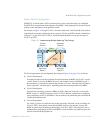
BLADEOS 6.5.2 Application Guide
BMD00220, October 2010 Chapter 8: Spanning Tree Protocols 117
Per-VLAN Spanning Tree Groups
STP/PVST+ mode supports a maximum of 127 STGs, with each STG acting as an independent,
simultaneous instance of STP.
Multiple STGs provide multiple data paths which can be used for load-balancing and redundancy.
To enable load balancing between two G8124s using multiple STGs, configure each path with a
different VLAN and then assign each VLAN to a separate STG. Since each STG is independent,
they each send their own IEEE 802.1Q tagged Bridge Protocol Data Units (BPDUs).
Each STG behaves as a bridge group and forms a loop-free topology. The default STG 1
automatically contains any newly configured VLANs until they can be assigned to another STG.
STGs 2-128 may contain only one VLAN each.
Using Multiple STGs to Eliminate False Loops
Figure 11 shows a simple example of why multiple STGs are needed. In the figure, two ports on a
G8124 are connected to two ports on an application switch. Each of the links is configured for a
different VLAN, preventing a network loop. However, in the first network, since a single instance
of Spanning Tree is running on all the ports of the G8124, a physical loop is assumed to exist, and
one of the VLANs is blocked, impacting connectivity even though no actual loop exists.
Figure 11 Using Multiple Instances of Spanning Tree Group
In the second network, the problem of improper link blocking is resolved when the VLANs are
placed into different Spanning Tree Groups (STGs). Since each STG has its own independent
instance of Spanning Tree, each STG is responsible only for the loops within its own VLAN. This
eliminates the false loop, and allows both VLANs to forward packets between the switches at the
same time.
VLAN 1
VLAN 30
Application Switch
BLADE Switch
False
Loop
Application Switch
BLADE Switch
VLAN 1
is active
STG 1
VLAN 30
is active
STG 2
x
With a single Spanning Tree,
one link becomes blocked.
Using multiple STGs,
Both links may be active.


















